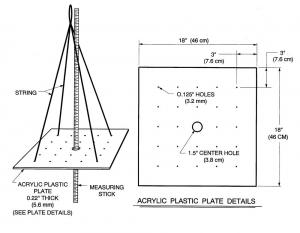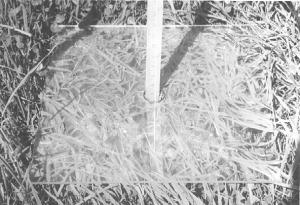1998 - Volume #22, Issue #3, Page #42
[ Sample Stories From This Issue | List of All Stories In This Issue | Print this story
| Read this issue]
Build Yourself A Low-Cost "Pasture Meter"
 |
 |
Ed Rayburn's meter measures bulk height of pastures, making it easy to estimate dry matter yield per acre.
"The key is calibrating it for the particular pasture where you plan to use it," says Rayburn. "In our case, that's a cool season grass/legume mix under rotational grazing."
His meter consists of an 18-in. sq., 0.22-in. thick Acrylite or Plexiglas plate with a 1 1/2-in. dia. hole drilled in the center. Twenty-four 1/8-in. dia. holes are drilled along five lines spaced 5 in. apart and starting 3 in. from the plate's edge. A yardstick extends through the middle hole, tied to the plate with a string.
To use, you simply walk through a pasture and take samples at random by placing the tip of the yardstick on the ground and lowering the plate until the forage canopy supports it. Then measure the height of the top of the plate above the ground.
For an accurate estimate of forage mass, Rayburn recommends taking 30 samples - in both high and low producing areas - per pasture.
For every inch of pasture height, there are 432 lbs. of dry matter per acre. So if average forage height measured with the plate is 6 in., forage mass is 2,592 lbs. of dry matter per acre. Dry matter/bulk height calibration varies with species, season and location.
Contact: FARM SHOW Followup, Dr. Edward B. Rayburn, P.O. Box 6108, Ag Science Building, West Virginia University, Morgantown, W.Va. 26506-6108 (ph 304 293-2219 ext. 4209).

Click here to download page story appeared in.

Click here to read entire issue
To read the rest of this story, download this issue below or click here to register with your account number.




